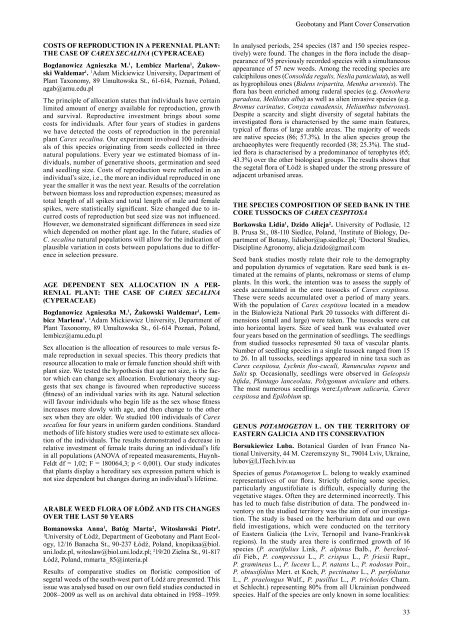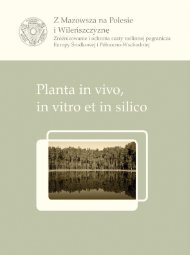acta societatis botanicorum poloniae - LV Zjazd Polskiego ...
acta societatis botanicorum poloniae - LV Zjazd Polskiego ...
acta societatis botanicorum poloniae - LV Zjazd Polskiego ...
Create successful ePaper yourself
Turn your PDF publications into a flip-book with our unique Google optimized e-Paper software.
COSTS OF rEPrOdUCTION IN A PErENNIAL PLANT:<br />
THE CASE OF cArex secAlinA (CYPErACEAE)<br />
Bogdanowicz Agnieszka M. 1 , Lembicz Marlena1 , żukowski<br />
Waldemar1 . 1Adam Mickiewicz University, Department of<br />
Plant Taxonomy, 89 Umultowska St., 61-614, Poznań, Poland,<br />
agab@amu.edu.pl<br />
The principle of allocation states that individuals have certain<br />
limited amount of energy available for reproduction, growth<br />
and survival. Reproductive investment brings about some<br />
costs for individuals. After four years of studies in gardens<br />
we have detected the costs of reproduction in the perennial<br />
plant Carex secalina. Our experiment involved 100 individuals<br />
of this species originating from seeds collected in three<br />
natural populations. Every year we estimated biomass of individuals,<br />
number of generative shoots, germination and seed<br />
and seedling size. Costs of reproduction were reflected in an<br />
individual’s size, i.e., the more an individual reproduced in one<br />
year the smaller it was the next year. Results of the correlation<br />
between biomass loss and reproduction expenses; measured as<br />
total length of all spikes and total length of male and female<br />
spikes, were statistically significant. Size changed due to incurred<br />
costs of reproduction but seed size was not influenced.<br />
However, we demonstrated significant differences in seed size<br />
which depended on mother plant age. In the future, studies of<br />
C. secalina natural populations will allow for the indication of<br />
plausible variation in costs between populations due to difference<br />
in selection pressure.<br />
AGE dEPENdENT SEx ALLOCATION IN A PErrENIAL<br />
PLANT: THE CASE OF cArex secAlinA<br />
(CYPErACEAE)<br />
Bogdanowicz Agnieszka M. 1 , żukowski Waldemar1 , Lembicz<br />
Marlena1 . 1Adam Mickiewicz University, Department of<br />
Plant Taxonomy, 89 Umultowska St., 61-614 Poznań, Poland,<br />
lembicz@amu.edu.pl<br />
Sex allocation is the allocation of resources to male versus female<br />
reproduction in sexual species. This theory predicts that<br />
resource allocation to male or female function should shift with<br />
plant size. We tested the hypothesis that age not size, is the factor<br />
which can change sex allocation. Evolutionary theory suggests<br />
that sex change is favoured when reproductive success<br />
(fitness) of an individual varies with its age. Natural selection<br />
will favour individuals who begin life as the sex whose fitness<br />
increases more slowly with age, and then change to the other<br />
sex when they are older. We studied 100 individuals of Carex<br />
secalina for four years in uniform garden conditions. Standard<br />
methods of life history studies were used to estimate sex allocation<br />
of the individuals. The results demonstrated a decrease in<br />
relative investment of female traits during an individual’s life<br />
in all populations (ANOVA of repeated measurements, Huynh-<br />
Feldt df = 1,02; F = 180064,3; p < 0,001). Our study indicates<br />
that plants display a hereditary sex expression pattern which is<br />
not size dependent but changes during an individual’s lifetime.<br />
ARABLE WEED fLoRA of ŁóDź AND ItS CHANGES<br />
OVEr THE LAST 50 YEArS<br />
Bomanowska Anna1 , Batóg Marta2 , Witosławski Piotr1 .<br />
1University of Łódź, Department of Geobotany and Plant Ecology,<br />
12/16 Banacha St., 90-237 Łódź, Poland, knopikaa@biol.<br />
uni.lodz.pl, witoslaw@biol.uni.lodz.pl; 219/20 Zielna St., 91-817<br />
Łódź, Poland, mmarta_85@interia.pl<br />
Results of comparative studies on floristic composition of<br />
segetal weeds of the south-west part of Łódź are presented. This<br />
issue was analysed based on our own field studies conducted in<br />
2008– 2009 as well as on archival data obtained in 1958– 1959.<br />
Geobotany and Plant Cover Conservation<br />
In analysed periods, 254 species (187 and 150 species respectively)<br />
were found. The changes in the flora include the disappearance<br />
of 95 previously recorded species with a simultaneous<br />
appearance of 57 new weeds. Among the receding species are<br />
calciphilous ones (Consolida regalis, Neslia paniculata), as well<br />
as hygrophilous ones (Bidens tripartita, Mentha arvensis). The<br />
flora has been enriched among ruderal species (e.g. Oenothera<br />
paradoxa, Melilotus alba) as well as alien invasive species (e.g.<br />
Bromus carinatus, Conyza canadensis, Helianthus tuberosus).<br />
Despite a scarcity and slight diversity of segetal habitats the<br />
investigated flora is characterised by the same main features,<br />
typical of floras of large arable areas. The majority of weeds<br />
are native species (86; 57.3%). In the alien species group the<br />
archaeophytes were frequently recorded (38; 25.3%). The studied<br />
flora is characterised by a predominance of terophytes (65;<br />
43.3%) over the other biological groups. The results shows that<br />
the segetal flora of Łódź is shaped under the strong pressure of<br />
adjacent urbanised areas.<br />
THE SPECIES COMPOSITION OF SEEd BANK IN THE<br />
COrE TUSSOCKS OF cArex cesPitosA<br />
Borkowska Lidia1 , dzido Alicja2 . University of Podlasie, 12<br />
B. Prusa St., 08-110 Siedlce, Poland, 1Institute of Biology, Department<br />
of Botany, lidiabor@ap.siedlce.pl; 2Doctoral Studies,<br />
Discipline Agronomy, alicja.dzido@gmail.com<br />
Seed bank studies mostly relate their role to the demography<br />
and population dynamics of vegetation. Rare seed bank is estimated<br />
at the remains of plants, nekromass or stems of clump<br />
plants. In this work, the intention was to assess the supply of<br />
seeds accumulated in the core tussocks of Carex cespitosa.<br />
These were seeds accumulated over a period of many years.<br />
With the population of Carex cespitosa located in a meadow<br />
in the Białowieża National Park 20 tussocks with different dimensions<br />
(small and large) were taken. The tussocks were cut<br />
into horizontal layers. Size of seed bank was evaluated over<br />
four years based on the germination of seedlings. The seedlings<br />
from studied tussocks represented 50 taxa of vascular plants.<br />
Number of seedling species in a single tussock ranged from 15<br />
to 26. In all tussocks, seedlings appeared in nine taxa such as<br />
Carex cespitosa, Lychnis flos-cuculi, Ranunculus repens and<br />
Salix sp. Occasionally, seedlings were observed in Geleopsis<br />
bifida, Plantago lanceolata, Polygonum aviculare and others.<br />
The most numerous seedlings were:Lythrum salicaria, Carex<br />
cespitosa and Epilobium sp.<br />
GENUS PotAmoGeton L. ON THE TErrITOrY OF<br />
EASTErN GALICIA ANd ITS CONSErVATION<br />
Borsukiewicz Luba. Botanical Garden of Ivan Franco National<br />
University, 44 M. Czeremszyny St., 79014 Lviv, Ukraine,<br />
lubov@LITech.lviv.ua<br />
Species of genus Potamogeton L. belong to weakly examined<br />
representatives of our flora. Strictly defining some species,<br />
particularly angustifoliate is difficult, especially during the<br />
vegetative stages. Often they are determined incorrectly. This<br />
has led to much false distribution of data. The pondweed inventory<br />
on the studied territory was the aim of our investigation.<br />
The study is based on the herbarium data and our own<br />
field investigations, which were conducted on the territory<br />
of Eastern Galicia (the Lviv, Ternopil and Ivano-Frankivsk<br />
regions). In the study area there is confirmed growth of 16<br />
species (P. acutifolius Link, P. alpinus Balb., P. berchtoldii<br />
Fieb., P. compressus L., P. crispus L., P. friesii Rupr.,<br />
P. gramineus L., P. lucens L., P. natans L., P. nodosus Poir.,<br />
P. obtusifolius Mert. et Koch, P. pectinatus L., P. perfoliatus<br />
L., P. praelongus Wulf., P. pusillus L., P. trichoides Cham.<br />
et Schlecht.) representing 80% from all Ukrainian pondweed<br />
species. Half of the species are only known in some localities:<br />
33



